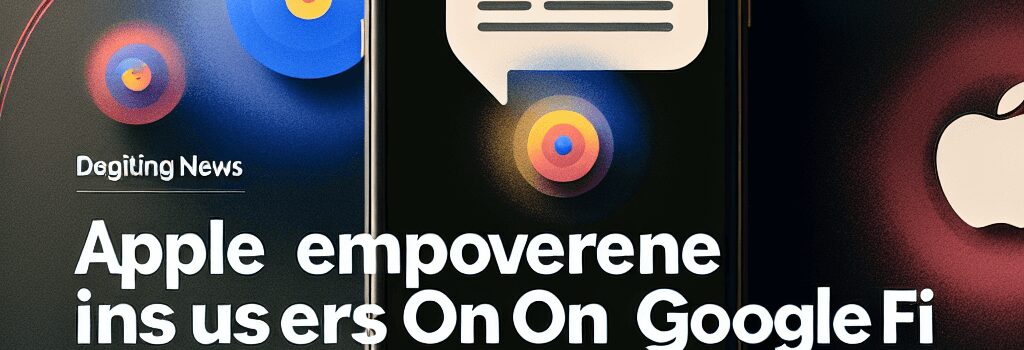Apple Empowers iPhone Users on Google Fi with RCS Messaging Support

An Evolution in Cross-Platform Messaging
For years, iPhone users have experienced a segregated messaging experience compared to their Android counterparts. Apple’s long-stand reluctance to integrate the Rich Communication Services (RCS) protocol resulted in iMessage offering a vastly enhanced experience for Apple users, leaving Android devices — including those on Google Fi — with limited capabilities. With the release of iOS 18.4, Apple finally expands its support for RCS messaging, bringing a host of advanced features to Google Fi subscribers on iPhone.
The updated system not only bridges the gap between differing platforms but also enables iPhone users to enjoy longer messages, high-definition media transfer, typing indicators, read receipts, and more, mirroring the feature-rich experience traditionally native to Android’s messaging environment. This change marks a significant shift in Apple’s messaging ecosystem strategy, acknowledging the widespread adoption and enhanced functionality promised by the RCS standard.
Technical Implementation and Enhanced Features
Technically speaking, the integration of RCS into iOS required Apple to interface with backend services, such as Google’s Jibe platform, which played a crucial role in reviving the RCS standard globally. In earlier implementations of RCS with iOS 18, support was limited to postpaid plans on the three major carriers, leaving MVNOs like Google Fi on the periphery. With the iOS 18.4 update, the support has finally been extended to include Google Fi and a range of T-Mobile MVNOs.
Behind the scenes, the new RCS integration involves a series of server registrations and data synchronization processes. When users toggle on RCS within their Messages settings (found under Apps > Messages > Text Messaging), their phone numbers are registered with the Google Fi RCS server. This seamless backend implementation relies on persistent data channels to ensure that messages, high-definition files, and presence information are exchanged reliably, even when the device is not on Wi-Fi. Additionally, care has been taken to maintain a secure channel for these communications, leveraging modern encryption standards where applicable.
Security and Efficiency in Messaging
The switch to RCS introduces not only richer media and functionality but also significant improvements in messaging security and efficiency. RCS inherently supports advanced encryption techniques that are continually evolving. Industry experts note that while end-to-end encryption for RCS is still in its early phases compared to iMessage’s robust security, the incremental improvements are a positive step toward uniform messaging security across platforms.
Furthermore, the RCS protocol is designed to be data efficient. However, users on plans like Google Fi’s ‘Flexible’ option should be mindful of potential data usage fluctuations, as RCS messaging consumes data outside Wi-Fi environments. Experts recommend checking plan details and monitoring data consumption to avoid unexpected charges.
Future Implications and Industry Perspectives
Apple’s shift towards RCS is a response to long-standing criticism regarding its walled garden approach to messaging. For years, the ‘blue bubble’ vs. ‘green bubble’ debate was more than superficial aesthetics; it symbolized a deeper divide between proprietary and open standards in mobile communications. By embracing RCS, Apple not only improves user experience for iPhone users interacting with non-Apple devices but also aligns itself more closely with industry standards, reducing friction in cross-platform communications.
Leading analysts and tech pundits have weighed in on the update. According to several experts, this integration could catalyze further convergence of messaging protocols, blurring the traditional lines between iOS and Android ecosystems. With the rapid evolution of communication standards and the increasing role of AI-driven messaging enhancements, the move by Apple is seen as both timely and strategically sound. The industry, as well as end users, now look forward to smoother interactions, richer media experiences, and potentially more innovations on the horizon.
Getting Started with RCS on Google Fi
For Google Fi users on iPhone, enabling RCS is straightforward. With the rollout of iOS 18.4, users should navigate to:
- Apps > Messages
- Text Messaging section
- Toggle on RCS support
It may take a few minutes for your phone number to be registered with the Fi RCS server following the toggle. Once activated, the transition should be smooth, allowing for a seamless messaging experience that now rivals that of Android’s native capabilities.
As the tech landscape continues to evolve, Apple’s incremental embrace of open communication protocols like RCS hints at a broader industry shift—one that increasingly values interoperability and user-centric innovation over proprietary exclusivity. The long-awaited convergence of messaging standards not only improves the immediate user experience for millions but also sets the stage for the next generation of mobile communication technologies.